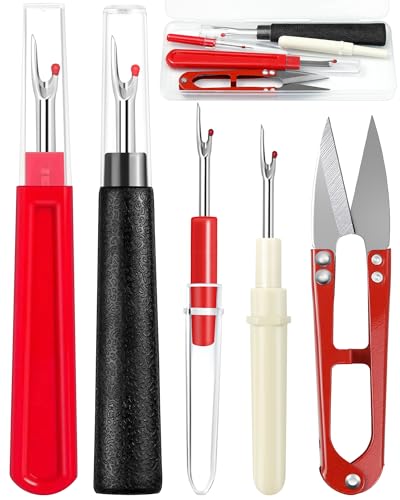Your sewing machine suddenly stops mid-project? It can be frustrating when a jam interrupts your creative flow. But don’t worry – fixing a jammed sewing machine is easier than you might think.
With a few simple steps, you’ll have your machine running smoothly again in no time. Whether you’re a seasoned sewer or just starting out, this guide will help you troubleshoot and resolve common jam issues quickly.
Common Causes Of Sewing Machine Jams
Jammed sewing machines disrupt your projects, but understanding common causes helps prevent them. Addressing these issues keeps your machine running smoothly.
Thread Issues
Improper threading often leads to jams. Ensure the thread follows the machine’s threading path accurately. Use high-quality thread to minimize tangling and breakage. Tension settings play a crucial role; incorrect tension can cause threads to bunch or snap. Regularly clean the bobbin area to remove lint and debris that obstruct thread flow. Additionally, avoid using old or frayed threads, as they are more prone to causing jams.
Needle Problems
Dull or bent needles frequently cause machine jams. Replace needles after every few projects to maintain optimal performance. Ensure the needle type matches your fabric; using the wrong needle can lead to snags and breaks. Insert the needle correctly, making sure it faces the right direction. A loose needle can also disrupt stitching, so tighten it securely. Regularly inspect the needle for damage and replace it immediately if you notice any issues.
Preparing To Fix The Jam
Before you begin fixing a jammed sewing machine, take these essential steps to ensure safety and efficiency.
Unplugging The Machine
Disconnect your sewing machine from the power source. This prevents accidental starts and ensures your safety while you work on the machine.
Clearing The Area
Remove any fabric, thread, and debris around the machine. Clearing the workspace helps you easily access the jammed parts and avoids further complications during the repair.
Step-By-Step Troubleshooting
Follow these steps to resolve a jammed sewing machine quickly and efficiently.
Removing The Jammed Thread
- Unwind the Thread: Gently pull back the upper thread and remove any tangled strands.
- Access the Bobbin Area: Open the bobbin cover to inspect for stuck threads.
- Remove the Bobbin: Take out the bobbin and clear any thread debris.
- Use Tweezers: Carefully extract remaining threads from the needle and feed dogs using tweezers.
- Check the Hook Race: Inspect the hook race for tangled threads and remove them to prevent future jams.
Cleaning The Machine
- Turn Off and Unplug: Ensure the machine is off and disconnected from power.
- Brush Out Lint: Use a small brush to remove lint from the bobbin area and feed dogs.
- Oil the Machine: Apply sewing machine oil to designated parts as per the manufacturer’s instructions.
- Wipe Down Surfaces: Clean exterior parts with a lint-free cloth to prevent buildup.
- Regular Maintenance: Schedule regular cleaning sessions to keep your machine running smoothly and avoid future jams.
Preventing Future Jams
Keep your sewing machine running smoothly by following these essential practices.
Regular Maintenance
Regular maintenance ensures your machine operates efficiently. Clean the bobbin area and remove lint after each use. Oil moving parts monthly using manufacturer-recommended oil. Inspect and replace needles weekly to prevent bends and dullness. Tighten any loose screws and check threading paths for obstructions. Schedule professional servicing annually to address wear and tear, keeping your machine in optimal condition.
Using Quality Materials
Using quality materials reduces the risk of future jams. Select high-quality threads, such as polyester or cotton, to minimize tangling and breakage. Choose the correct needle type for your fabric—sharp needles for woven fabrics and ballpoint needles for knits. Invest in sturdy bobbins and ensure they are properly inserted. Opt for fabrics that match your project’s requirements, avoiding overly thick or slippery materials that can cause feeding issues.
When To Seek Professional Help
Even after following troubleshooting steps, some issues require expert attention. Recognizing these situations ensures your sewing machine receives the care it needs.
Persistent Jams
If your machine continues to jam despite thorough troubleshooting, professional intervention is necessary. Persistent problems might indicate deeper mechanical issues that require specialized tools and knowledge.

Unusual Noises
Strange sounds, such as grinding or squeaking, suggest internal components may be damaged or misaligned. A technician can diagnose and repair these issues, preventing further damage.
Electrical Problems
Electrical faults, like inconsistent power or the machine not turning on, go beyond mechanical fixes. Certified professionals can safely address wiring issues and replace faulty parts.
Unidentifiable Causes
When you can’t determine the source of a jam, seeking expert help is advisable. Technicians can inspect areas you might miss and identify hidden problems within the machine.
Complex Repairs
Advanced repairs, including motor malfunctions or electronic component failures, require professional skills. Attempting these fixes without expertise can worsen the damage.
Maintenance and Servicing
Regular professional maintenance extends your machine’s lifespan. Scheduling annual servicing ensures all components function smoothly and reduces the risk of future jams.
Warranty and Manufacturer Support
« How to Get Feedback on Your Sewing Work: Unlock Secrets to Sewing Success
10 Best Online Communities for Sewing Education Every Sewist Should Join »
If your machine is under warranty, contacting the manufacturer’s authorized service center is crucial. Professional repairs within the warranty terms protect your investment and maintain eligibility for support.
Specialized Machines
High-end or specialized sewing machines often need trained technicians familiar with specific models. Professionals can handle unique features and complex mechanisms effectively.
By knowing when to seek professional help, you maintain your sewing machine’s performance and longevity, ensuring a seamless crafting experience.
Conclusion
Dealing with a jammed sewing machine doesn’t have to derail your projects. With the right steps, you can quickly get back to sewing without too much hassle. Remember to stay patient and take your time when troubleshooting issues. Keeping your machine well-maintained makes a big difference in preventing future jams.
Embrace the satisfaction that comes from solving these problems on your own. Each fix builds your confidence and skills, making your sewing experience even more enjoyable. Keep experimenting and don’t be afraid to seek help when needed. Happy sewing!


















